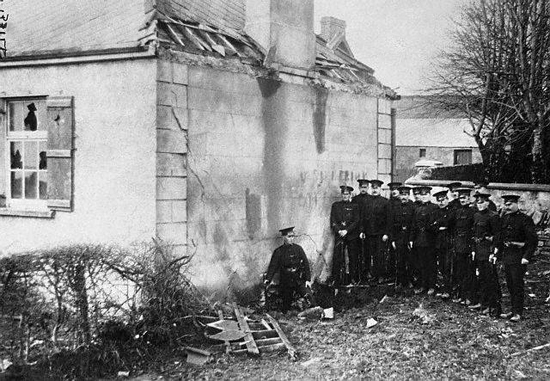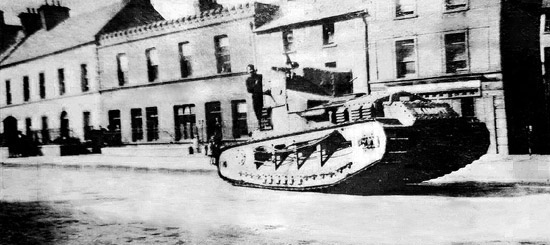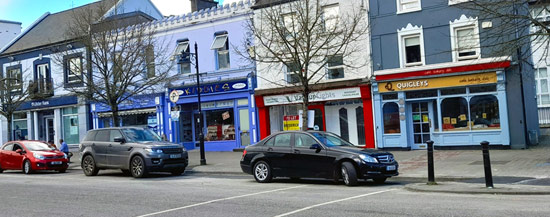Desperate Attack at Holycross.
Barrack Riddled – Marvellous Escapes.
[As exactly published, on Saturday, January 24th, 1920, by the Nenagh Guardian. Brigades Involved: 2 Tipperary Brigade (Mid Tipperary) – 2 Southern Division.
Simultaneously, with the Drombane battle on Sunday night, (January 18th, 1920, two days before the sacking of Thurles), a large party of armed men attacked Holycross police barracks.

Holycross barracks is about four miles from Thurles and five (miles) from Drombane. The barrack stands in the middle of a thickly wooden country, about one mile beyond the historic Abbey of Holy Cross, on the road to Cashel and there are few houses in the vicinity.


The attackers opened a fierce fire, shortly before 9 o’clock, some of the bullets evidently coming from the tree tops and front roof of a dwelling opposite the building. The police garrison of 9 men vigorously replied; the besieged citadel spitting out an incessant stream of bullets and hand grenades, while occasionally relief rockets were sent up.
Like an earthquake.
In the thick of the onset, a party of the attackers dashed right up to the barracks carrying ladders, pickaxes, sledges and crowbars. They made for the eastern gable, which having no windows or opening, when once reached, would place the attackers out of the danger zone. Two bombs were placed in position and a loud explosion followed. The noise of the explosion was heard in Thurles and according to defending constables, the whole building rocked and reeled as if there was an earthquake.
Nobody, however, was injured but a portion of the roof was blown away and a huge hole was made in the ground. During the attack the raiders placed a long ladder against the gable and hacked a hole, about 2-ft square, on the top portion of the wall, but did not penetrate fully. Evidently it was intended to hurl explosives through the aperture on the defenders.
The battle raged with unabated vigour and occasionally above the din could be heard, now and then, the screaming of the children in the house opposite the barracks; the roof of which was occupied by snipers.
Notwithstanding that rockets were frequently sent up by the garrison, no relief came and at 10:30 the attackers fire ceased, owing it is believed to a lack of ammunition. Another theory is that the ceasefire was ordered because it was thought, owing to the screaming of the children, that somebody in the house had been hit. During the attack all roads leading to Holycross were blocked by felled trees, while all telegraph wires in the neighbourhood had been cut. All person’s travelling in the district were held up and kept prisoner by armed outpost.
Policeman Captured.
Constable Donoghue (Name may be incorrect as other reports state Constable McCloskey), when returning to his station, was captured, blindfolded, searched and held prisoner, while the attack was in progress. A party of card players returning home were also held up and detained in custody by the attackers. The mansion of Mr C. N. Clark D.L. (Deputy Lieutenant) landlord of the barracks is 100 yards away and this was closely guarded during the attack; nobody being allowed in or out.
Question in Parliament:
Mr. James Lonsdale, (Unionist Member of Parliament for Mid Armagh from January 1918 until his death in 1921).
To ask the Chief Secretary to the Lord-Lieutenant of Ireland whether he has received particulars of the attack made by a crowd of persons on the house of Mr. Charles N. Clarke, D.L., at Holycross, County Tipperary, on the night of the 17th (18th) instant; what damage was done to the house; were any of the police injured; and have any proceedings been taken against those who organised the attack.
Answered by Mr. Augustine Birrell. (British Liberal Party politician, who previously was Chief Secretary to the Lord Lieutenant of Ireland from 1907 to 1916.)
Eight arrests have been made this morning in connection with this case. As proceedings are pending, it is not desirable to enter into further particulars.
All the windows are smashed, some bullets having pierced the steel shutters, while all the woodwork is riddled with bullets, some of which can be seen sticking out of the timber. Notwithstanding all the bullets and grenades fired not one drop of blood was spilled. (Some of the police did receive cuts from glass splinters) The force of the explosion was so great that some of the houses in the village where shaking.
An old age pensioner living a mile from the scene said that as soon as he heard the firing and saw the flare of the rockets, he knew “there was some devilment going on”, and he went to bed on the spot.
The newspaper article concludes.
Involved in the Holycross attack on the barrack on that Sunday night, January 18th, 1920 where:- Paddy Ryan, Richard and James Phelan, James Kelly, Hugh Long, Patrick Lennon, Michael Bartley, Richard (Dick) Scott, Richard (Dick) Purcel, Mathew Connolly, Edmund Maher, Thomas Moore, William Phelan, Jack Moore, James Kealy, Jack Darcy, Christy Cody, Michael (Mick) Coady, Michael (Mick) Ward, Bill Buckley, Patrick Purcell, Watt Buckley, James Alexander, John McConnell, Michael Maher and Patrick Moore.
The main purpose of the attack was to acquire further arms, explosives and ammunition.

Leave a Reply